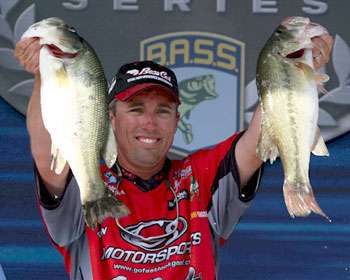
When he's not fishing the Bassmaster Elite Series, North Carolina pro Britt Myers considers himself a "weekend fisherman." He works at his auto customizing business all week and then hits the lake with the rest of the 9-to-5 warriors.
Once the swarm of boats hits the water, he has found, the fish retreat to protected places, whether that be deep water or extreme shade. On Myers' home waters, Lake Wylie, N.C., extreme shade is provided by hundreds of boat docks, some of which hold winning stringers of fish nearly year-round.
For Myers, not all docks are created equal: Some hold no fish; some hold one fish; and some hold multiple fish. When fishing pressure hits its peak, Myers focuses on docks that harbor mini-schools of bass. But even when he locates these wolf packs, ravenous though they may be, it's not always easy to extract more than one fish.
In that respect, Myers says that "every lake is different. On some lakes you hook one bass, and four come out with it. But you can go back five times and never get another bite. On other lakes, you can catch one each time you go back."
Myers says that when fishing tidal waters, it's a particularly good strategy to revisit productive docks. As the tidal flow changes, new bass will move in and replace those that have been deposited in livewells or that have moved.
In many cases, Myers believes that it's not even necessary to make multiple trips to the same docks in order to load the boat. Instead, you can stay put, and wait for the bass to settle down.
One tool that makes it possible for him to do that is his Power Pole anchor system. Not only does it allow him to make precise casts without having to counteract wind or boat wakes, but it also eliminates an anchor's tendency to stir up the water.
"A lot of times you catch one, hit the trolling motor and put the bass in the livewell," Myers explains. "That little burst of trolling motor will spook the fish that followed." If that happens, Myers has found that it will often take up to 30 minutes for the other bass around the dock to settle down again.
When searching out docks loaded with bass, Myers believes that those with "long, flat docks are usually the best, particularly if they have a rock or a hard spot under them. Anything that makes them different from other docks, such as a launch ramp off to the side, can provide a clue." Once he finds a dock that holds a group of bass, he looks for others with similar characteristics. Put another way, he puts together a dock pattern in the same way you would in ledge fishing or flipping cover.
Regardless of where he fishes, Myers' initial search tool is almost always a 1/2-ounce JymSu Flip/Swim Jig. "I keep it simple," he says. "I like black and blue if the water's a little dirty and something like green pumpkin if it's clearer."
Myers claims that it's possible to rely on just a handful of docks and do well, whether the bite is a tough, grind-'em-out affair or a wide-open slugfest. "I've fished tournaments in which I caught two of my fish off one dock and three fish on a second dock, just by going back and forth between them," he says.
So when you catch that first dock fish, stick around for a bit. You will be surprised at how little cover it takes to produce a winning pier. At the very least, circle back after a while. It might be the best decision you make all day.





